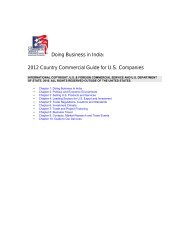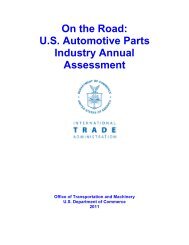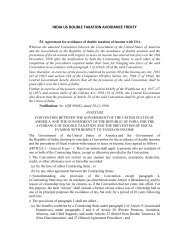Importing into the United States - Indo-American Chamber Of ...
Importing into the United States - Indo-American Chamber Of ...
Importing into the United States - Indo-American Chamber Of ...
You also want an ePaper? Increase the reach of your titles
YUMPU automatically turns print PDFs into web optimized ePapers that Google loves.
B. Percent by area of external surface area of upper<br />
(including all reinforcements and accessories).<br />
Which is rubber<br />
__________%<br />
and/or plastics<br />
__________%<br />
C. Percent by weight of rubber and/or plastics is<br />
__________%<br />
D. Percent by weight of textile materials plus<br />
rubber and/or plastics is __________%<br />
E. Is it waterproof?<br />
F. Does it have a protective metal toe cap?<br />
G. Will it cover <strong>the</strong> wearer’s ankle bone?<br />
H. Will it cover <strong>the</strong> wearer’s knee cap?<br />
I. [Reserved.]<br />
J. Is it designed to be a protection against water,<br />
oil, grease, or chemicals or cold or inclement<br />
wea<strong>the</strong>r?<br />
K. Is it a slip-on?<br />
L. Is it a downhill or cross-country ski boot?<br />
M. Is it serious sports footwear o<strong>the</strong>r than ski<br />
boots? (Chapter 64 subheading note defines<br />
sports footwear.)<br />
N. Is it a tennis, basketball, gym, or training shoe or<br />
<strong>the</strong> like?<br />
O. Is it made on a base or platform of wood?<br />
P. Does it have open toes or open heels?<br />
Q. Is it made by <strong>the</strong> (lipped insole) welt construction?<br />
R. Is it made by <strong>the</strong> turned construction?<br />
S. Is it worn exclusively by men, boys or youths?<br />
T. Is it made by an exclusively adhesive construction?<br />
U. Are <strong>the</strong> fibers of <strong>the</strong> upper, by weight, predominately<br />
vegetable fibers?<br />
V. Is it disposable, i.e., intended for one-time use?<br />
W. Is it a “Zori”?<br />
X. Is <strong>the</strong> lea<strong>the</strong>r in <strong>the</strong> upper pigskin?<br />
Y. Are <strong>the</strong> sole and supper made of wool felt?<br />
Z. Is <strong>the</strong>re a line of demarcation between <strong>the</strong> outer<br />
sole and upper?<br />
The information requested above may be furnished<br />
on CF 5523 or o<strong>the</strong>r appropriate format by <strong>the</strong><br />
exporter, manufacturer or shipper.<br />
Also, <strong>the</strong> following information must be furnished<br />
by <strong>the</strong> importer or his authorized agent if<br />
classification is claimed under one of <strong>the</strong> subheadings<br />
below, as follows:<br />
If subheading 6401.99.80, 6402.19.10, 6402.30.30,<br />
6402.91.40, 6402.99.15, 6402.99.30, 6404.11.40,<br />
6404.11.60, 6404.19.35, 6404.19.40, or 6404.19.60 is<br />
claimed:<br />
Does <strong>the</strong> shoe have a foxing or foxing-like band?<br />
If so, state its material(s).<br />
Does <strong>the</strong> sole overlap <strong>the</strong> upper o<strong>the</strong>r than just<br />
at <strong>the</strong> front of <strong>the</strong> toe and/or at <strong>the</strong> back of <strong>the</strong> heel?<br />
Definitions for some of <strong>the</strong> terms used in Question A<br />
to Z above: For <strong>the</strong> purpose of this section, <strong>the</strong><br />
following terms have <strong>the</strong> approximate definitions<br />
below. If ei<strong>the</strong>r a more complete definition<br />
or a decision as to its application to a particular<br />
article is needed, <strong>the</strong> marker or importer of<br />
record (or <strong>the</strong> agent of ei<strong>the</strong>r) should contact<br />
Customs prior to entry of <strong>the</strong> article.<br />
a. In an exclusively adhesive construction, all of<br />
<strong>the</strong> pieces of <strong>the</strong> bottom would separate from<br />
<strong>the</strong> upper or from each o<strong>the</strong>r if all adhesives,<br />
cements, and glues were dissolved. It includes<br />
shoes in which <strong>the</strong> pieces of <strong>the</strong> upper are<br />
stitched to each o<strong>the</strong>r, but not to any part of <strong>the</strong><br />
bottom. Examples include:<br />
1. Vulcanized construction footwear;<br />
2. Simultaneous molded construction foot<br />
wear;<br />
3. Molded footwear in which <strong>the</strong> upper and <strong>the</strong><br />
bottom is one piece of molded rubber or<br />
plastic; and<br />
4. Footwear in which staples, rivets, stitching,<br />
or any of <strong>the</strong> methods above are ei<strong>the</strong>r primary<br />
or even just extra or auxiliary, even<br />
though adhesive is a major part of <strong>the</strong> reason<br />
<strong>the</strong> bottom will not separate from <strong>the</strong> upper.<br />
b. Composition lea<strong>the</strong>r is made by binding<br />
toge<strong>the</strong>r lea<strong>the</strong>r fibers or small pieces of natural<br />
lea<strong>the</strong>r. It does not include imitation lea<strong>the</strong>rs<br />
not based on natural lea<strong>the</strong>r.<br />
c. Lea<strong>the</strong>r is <strong>the</strong> tanned skin of any animal from<br />
which <strong>the</strong> fur or hair has been removed. Tanned<br />
skins coated or laminated with rubber and/or<br />
plastics are “lea<strong>the</strong>r” only if lea<strong>the</strong>r gives <strong>the</strong><br />
material its essential character.<br />
d. A Line of Demarcation exists if one can indicate<br />
where <strong>the</strong> sole ends and <strong>the</strong> upper begins.<br />
For example, knit booties do not normally have<br />
a line of demarcation.<br />
e. Men’s, boy’s and youth’s sizes cover footwear<br />
of <strong>American</strong> youths size 11 and larger for males,<br />
and does not include footwear commonly worn<br />
by both sexes. If more than 4 percent of <strong>the</strong><br />
shoes sold in a given size will be worn by<br />
females, that size is “commonly worn by both<br />
sexes.”<br />
f. Footwear is designed to protect against water,<br />
oil or cold or inclement wea<strong>the</strong>r only if it is substantially<br />
more of a protection against those<br />
items than <strong>the</strong> usual shoes of that type. For<br />
example, a lea<strong>the</strong>r oxford will clearly keep your<br />
feet warmer and drier than going barefoot, but<br />
IMPORTING INTO THE UNITED STATES<br />
A-5
















